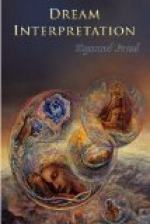|
This section contains 430 words (approx. 2 pages at 400 words per page) |

|
On Dreams Summary & Study Guide Description
On Dreams Summary & Study Guide includes comprehensive information and analysis to help you understand the book. This study guide contains the following sections:
This detailed literature summary also contains Topics for Discussion and a Free Quiz on On Dreams by Sigmund Freud.
On Dreams is published by Sigmund Freud in 1900, only a year after the longer, all encompassing Interpretation of Dreams was published. Freud wishes to give readers a more concise summary of his conclusions regarding dreams. Before Freud's investigations, little is known about dreams. Many do not believe that dreams really mean anything to the dreamer. Freud sets out to prove the opposite.
Unfortunately for us, dreams are not often presented in a clear, straightforward fashion. The dream language or content of the manifest dream is put together by several steps in the dream process or transformation. First, the latent content is condensed so that it is almost hidden in the dream. Secondly, the content has its main emphasis or importance shifted, thereby distorting the dream to the dreamer. Lastly the dream is put through revision so that the material can be organized into a more coherent structure. Freud then points out to the reader that sometimes the wishes in our dreams are further pressed. Our unconsciousness tries to purposefully repress things that we would rather not know about ourselves or let others know. This is similar to some phobias and mental disturbances.
Throughout the book, Freud analyzes a dream he has. He refers to this dream as the specimen dream. In the dream, Freud is with a woman (not his wife) at dinner. The woman tells him he has beautiful eyes and places her hand on his knee. She also tries to feed him spinach. Freud continually references this dream. Through dream work, Freud insists he has found the dream's real meaning. He wishes to attain love for the cost of nothing. Freud comes to this conclusion by writing down all of the manifest content of this dream. He then pulls in experiences from his waking life and draws connections between the occurrences. As the book progresses, Freud uses this mode of dream work to decipher patients' dreams. This is a form of analysis the Freud uses in other patients also.
In this book, Freud briefly discusses dream symbolism. Symbols have long been thought as an accurate way to diagnose dreams. While he agrees that dream symbols can be helpful, they should not be the only way that we interpret dreams. We should also still use dream interpretation because it allows us a unique view into the dreamer's own individual world. While others could argue that free interpretation leaves a lot of guess work up to the doctor or therapist, Freud thinks this is the most useful way to understand the point and purpose of dreams.
Read more from the Study Guide
|
This section contains 430 words (approx. 2 pages at 400 words per page) |

|



